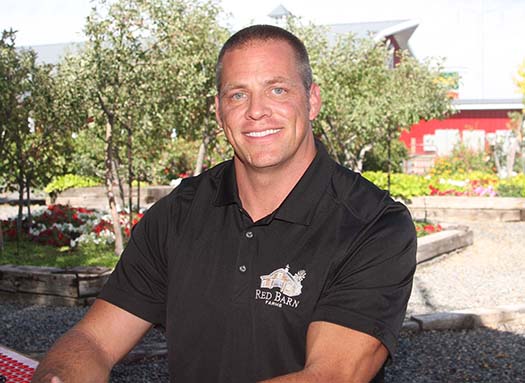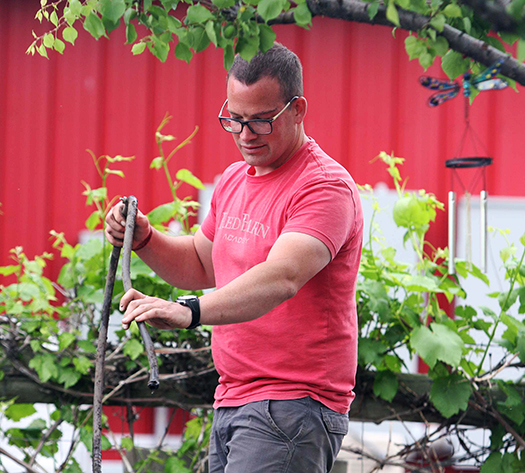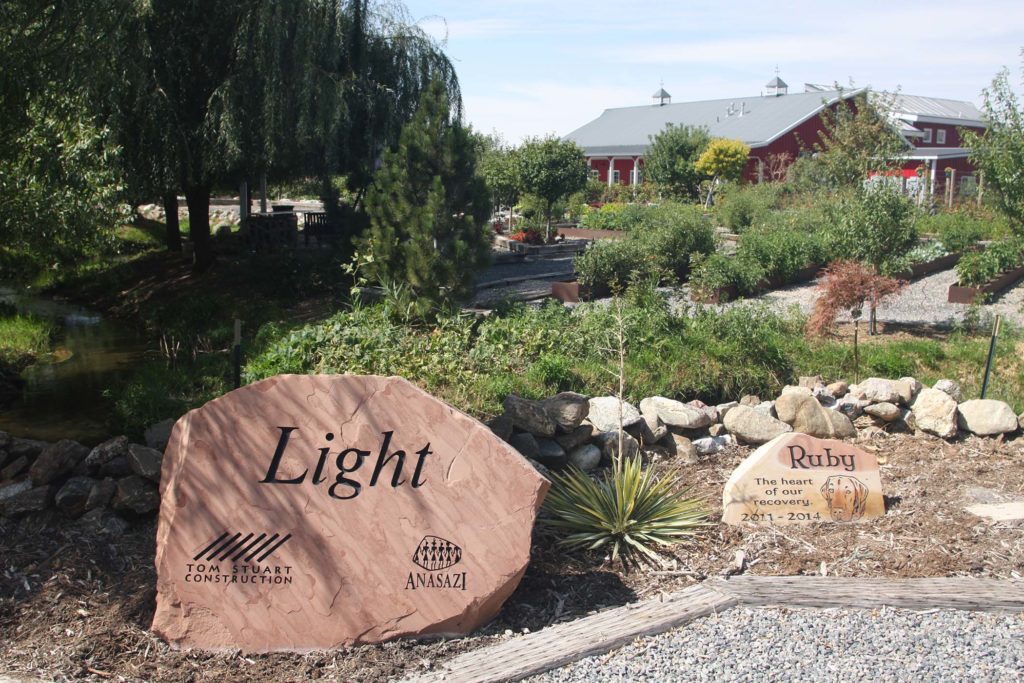One Last Shot
Life goes on pretty fast near Red Barn Academy.
Cars whiz by the road directly to the west, carrying people to the subdivisions and commercial areas surrounding Farmington Bay. To the east, the FrontRunner train speeds along the Wasatch Front as traffic on Interstate 15 barrels towards Salt Lake City at 70-plus miles per hour.
And on a warm day in early September, Mike Haws, ’00, is trying to keep pace with what’s going on around west Farmington.

Mike Haws, director of Red Barn Academy, in a rare moment of pause.
The former Utah State University golfer has been on the run all morning, having just returned from an oral surgeon’s office where a Red Barn student named Taylor had all his wisdom teeth removed. And as soon as Haws has Taylor safely in bed to recuperate, he’s back in his truck on his way to pick up a Red Barn lawn-care maintenance crew.
But Haws is hardly a stranger to sustained effort.
Although he plans to golf later with his father, former Utah State basketball star Rich Haws, ’75, Mike rarely gets out on the links these days. Instead, Haws, who is built more like a tight end than a golfer, prefers to compete in marathons, triathlons, and the infamously grueling Spartan Races designed to push competitors to their absolute limits.
“I don’t like who I am on the golf course,” Haws declares. “I’m way too intense for that now. I get more bang for my buck when I’m there running races.”
Because of that, hustling now has a whole new meaning for Haws. For a good part of his life, he admits that when he was “out there running and gunning” he wasn’t seeking a medal and a sense of accomplishment.
“There were three things that I was chasing: drugs, money, and sex,” Haws proclaims.
Haws’ first job after college was as a pharmaceutical representative, which gave him access to a lot of physician’s drug closets.
“That’s a great job for a drug addict, right?” Haws notes. “So, I would sit in the drug closets, and if the bottle said: ‘Don’t crush this,’ I would crush it. And if it said: ‘Don’t mix this with this,’ I would mix it. And I even got to the point where I had access to doctors’ DEA numbers, so I was calling in my own prescriptions because at that point I was taking 30 or 40 pills a day.
“That’s a lot of prescriptions that you’ve got to go out there and get filled,” Haws continues. “So, I became really kind of sneaky, and I behaved like the rules didn’t apply to me.”
Even though he’s all but hung up his clubs, you might say that Mike Haws has gone back to his golfing roots when it comes to rules.
As the director and co-founder of Red Barn Academy, Haws’ primary job is to find men who are desperate to change their lives after years of criminal behavior brought on by drug and alcohol addiction. Ideally, they spend the next two years at Red Barn, working to the point of exhaustion every day while slowly putting their past lives behind them.
The enforcement of rules is extremely important in competitive golf, and that includes having enough integrity to call a penalty on yourself whether or not anyone else may have witnessed the infraction. That’s why the 43-year-old gets up at 5 a.m. every morning and shaves—even while on vacation—because those are just a couple of the rules that students at Red Barn Academy are expected to adhere by.
“I tell these guys, ‘I’m not here to be your friend. I’m here to save your life. So, if you like me, I’m probably not doing my job,’” Haws says.
As the director and co-founder of Red Barn Academy, Haws’ primary job is to find men who are desperate to change their lives after years of criminal behavior brought on by drug and alcohol addiction. Ideally, they spend the next two years at Red Barn, working to the point of exhaustion every day while slowly putting their past lives behind them.
“Let’s give them one last shot because when they get here, they’re humbled and appreciative,” he says. “Their families have given up on them, the criminal justice system’s given up on them, and the judge is just ready to throw them in prison and lock them up,” Haws explains. “And so I advocate and tell the judge to give them one last shot. We see ourselves as the last house on the block, so what do they have to lose by sentencing them here to Red Barn?”
Haws makes it clear that Red Barn Academy is not a treatment center or a clinical program, but rather a “therapeutic community” where medications are not allowed. There is no cost to the students once they are accepted into the program, but they are expected to work hard during the day and attend workshops and growth sessions at night. And should they waver from the rules and expectations, they will not only have to answer to Haws, but also to the rest of the Red Barn community for their behavior.
“If they go to prison, they’ll cost taxpayers $40,000 a year, but we don’t have any government funding,” Haws says. “And I’ll tell the judge, ‘If they screw up here, I will personally drop them off at Point of the Mountain.’
“Let’s give them one last shot because when they get here, they’re humbled and appreciative,” he says.
Of course, not every student embraces the Red Barn way. Haws says he’s had individuals tell him that they just wanted to go back to prison because “I do better in the system.” But if they’re able to stick it out past those difficult early months, Haws says it’s easy to see a difference.
“Most of them are like a deer in headlights for 60 to 80 days,” Haws says. “But right around six or seven months you start to see this change happen, and it’s magical.”
Kade Lundgreen was the second student to ever sign on for the Red Barn Academy experience. A Richmond native, Lundgreen started “experimenting with various things” at age 18, and ended up spending a lot of time in jail over the next 10 years.
Finally, after being arrested again in August 2017, his sister came across a newspaper article about a completely new option. Lundgreen paid a visit to Red Barn Academy and found the facility comfortable after growing up on a farm.

Kade Lundgreen, a Red Barn Academy student, is devoted to the program.
He arrived on Oct. 3, 2017—two days after the academy opened—and admits that he didn’t really know what he was getting himself into. Lundgreen initially committed to one year, but has since decided to complete the entire two-year program … and probably beyond.
“And changing all of these behaviors boils down to one core value, and that’s integrity,” Lundgreen adds. “That’s what we believe in is honesty and integrity.”
“With everything that has been given to me, I would like to stay even longer and give back,” he says.
As of May 2019, Lundgreen was serving as the farm manager at Red Barn, while also being in charge of newcomers.
“I know I’m safe here, and I know I’m not going to get into trouble,” Lundgreen says. “Here we focus on the behaviors and lay it out rough. And I’ve learned it wasn’t necessarily the addiction I had a problem with, but it was the manipulation and the justifying, and that made me not feel so good about myself, so I coped with it through drugs.
“And changing all of these behaviors boils down to one core value, and that’s integrity,” Lundgreen adds. “That’s what we believe in is honesty and integrity.”
A success like Lundgreen means an awful lot to the Haws family. The death of Mike’s 21-year-old brother, Dustin, from a drug overdose on June 29, 2012, was not only the driving force behind him finally getting serious about his sobriety three weeks later, but also the impetus behind the creation of Red Barn Academy.
Dustin was living in a transitional home in Salt Lake City after completing a stint in rehab when he died. But Dustin and two other men left the unsupervised home one night and acquired heroin.
“One fled the scene and when the other one came to, he tried to revive my little brother, but it was too late. He was gone,” Haws recalls.
“I don’t like to talk about the organization because I really believe they have good motives and were trying to do the right thing, but we said to ourselves, ‘We’re face with two options here. The first option is to continue in denial that there is a problem in Davis County and here in Utah. Or we could use Red Barn and our resources to become part of the solution.”
“I was a lot worse than Dustin was when he died,” Haws says. “So, you can only imagine the guilt and shame I felt around my little brother dying from an overdose while I was still very active in my unhealthy behaviors.
Rich Haws left a basketball career behind to earn his master’s in economics. He became a successful real estate developer, helping to create the mixed-use planned development in the area of north Farmington that lies west of I-15. While creating Station Park and Park Lane Commons, Haws decided he wanted to keep the “farm” in Farmington and set aside a large piece of land and built a red barn on it in 2008, not knowing exactly what to do with it until Dustin died. Then the structure became a gathering place for support groups, and the whole idea of Red Barn Academy picked up steam as Mike got sober and completed a degree in social work so he could serve as licensed drug and alcohol counselor.
“I was a lot worse than Dustin was when he died,” Haws says. “So, you can only imagine the guilt and shame I felt around my little brother dying from an overdose while I was still very active in my unhealthy behaviors.
“I had already lost my best friend two months earlier, so when I lost Dustin, I just had this ‘Ah ha’ moment of ‘Holy s***! I’m next!’”
Mike Haws will never forget taking his first drink of alcohol during his junior year of high school.
“I was a late bloomer,” he says. “I was short and chubby and just didn’t fit in with the cool kids, and I was a golfer. We were always teased that we were wannabe athletes and golf wasn’t a real sport.
“But when I had that first drink, all of those insecurities went away, and I remember thinking, Man, [I’m] going to do this a lot because when I drink, I feel taller and stronger and felt like I could go talk to the girls,” he says.
Haws went to Utah State for a year before serving a two-year mission for the Church of Jesus Christ of Latter-day Saints in Ecuador. During his first year back in Logan, Haws was playing on the Aggie golf team when he says he decided to start working out.
Unfamiliar with proper weightlifting techniques, Haws was deadlifting when he says he “felt something pop in his back.” Diagnosed with a herniated disc in his lower spine, Haws received his first pain pills from the team doctor. Muscle relaxers came next as the doses were increased.
During the dark days of his addiction, Haws says he went to jail “at least 16 or 17 times,” but never went to prison, something he feels very fortunate about.
“It didn’t take me long to figure out that, ‘Oh, I can use these for the insecurities. I can use these in lieu of drinking. I can mask the paint and maybe depression and ansiety, and all of the pressure of going to school and trying to get good grades,’” Haws says. “I quickly started to develop not just a physical dependence on prescription medications, but a psychological, spiritual, and emotional dependence. I started using them when things were going good, and I started using them when things were going bad.”
During the dark days of his addiction, Haws says he went to jail “at least 16 or 17 times,” but never went to prison, something he feels very fortunate about.
“There’s such a big difference between sending a person to prison and sending them to jail. That kid right there,” he points across the room, “If he would have gone to prison, that would have completely changed the direction of his life and it wouldn’t have been good.”
“That kid” is John Benjamin Bell, a.k.a. Benny, a young man Haws talked a judge into letting come to Red Barn rather than going to prison. Although Benny couldn’t comprehend working on a farm and was “depressed and lazy,” he eventually embraced the hard work and structure the program provides in order to acquire vital life skills that he likely wouldn’t have had after a stint in the state penitentiary.
Benny recently started training to compete in his first Spartan Race in July alongside Haws.
“That’s what’s interesting about what we do here,” Haws says. “I don’t even try and pretend to guess who is going to be successful here or not because some of these guys just plod along, one day after another after another, until that light goes on and he’s on fire.”
Back in September 2018, Jason Webb was just starting to smolder, while Anthony Widner was still looking for a spark.
At the time, Webb was a Red Barn veteran, having arrived the previous April at the rather unusual age of 44. As part of the program’s “200 percent accountability” rule, Widner was paired up with Webb to work alongside each other practically from dawn to dusk during his first three weeks at Red Barn.

The Serenity Trail at Red Barn Academy is a short walkway where students can commit to the program while walking to the seven paths of Anasazi Way.
“That’s the whole thing, they want to change lives,” he says.
Widner, 27, was in out of jail for five years and had been to rehab twice when he was arrested in Davis County for possession with intent to distribute.
“That’s when I decided to come here to change my life because I needed something different,” Widner says. “And I feel very, very blessed to be here. It’s so humbling to be here around people that care about us and want us to do better.
“That’s the whole thing, they want to change lives,” he says.
In May 2019, it’s easy to see a difference in Widner. Once confined to the farm, he’s now on a landscaping crew and says his focus has slowly turned away from worrying about himself to trying to help newcomers.
“They say don’t get too comfortable because this place is made to make you feel uncomfortable, but it’s like every day is a little bit easier,” explains Widner, who made it through the pain of hernia surgery last January on the strength of just ibuprofen and willpower.
“It’s a two-year program, but I plan on staying here longer than that just to make sure I get this down and don’t go out there and mess it up,” he says.
Meanwhile, Webb couldn’t be happier to have gotten his driver’s license back in the spring—the first time he’s had a valid license since 2010. The Utah County native, who says his drug addiction cost him his wife and three children, first got hooked on painkillers after having heart surgery in 2001.
“There’s no way you could deal with it without some sort of medication, but it’s so much medication that you’re pretty much addicted when you recover,” says Webb. “Cough with a wired-up sternum, and it’s a whole new level of pain.”
Webb is now part of a Red Barn crew helping to build a nearby middle school. In addition to construction and farm labor, Red Barn students are also involved with commercial and residential landscaping and a moving company. The academy is also partnering with the Slaymaker Group on a new restaurant venture called Sticky Bird, the first of which will be staffed primarily by Red Barn students.
Construction is underway on a three-story building nearby which houses additional office space, as well as the Arbinger Institute, a group helping develop a training program for family members of Red Barn students. There are also plans to build a new bunkhouse to more than triple the amount of student beds available and someday add women to the facility.
“There are huge things happening here, and it’s really cool to be a part of this,” Widner says.
Big things have happened in Haws’ life, as well. He married Tawni Goldsberry five years ago, and the couple has a one-year-old son named Maverick. Now seven years sober, Haws knows he has to stay the course because “I don’t have any other option. I don’t have another relapse in me. If I do, you’ll probably read about me in the obituaries.”
“But,” Haws adds, “I know that if I stay the course, my son will never have to see his dad drunk or come visit his dad in jail. I’ve got to be a good husband and father, and also be a good example for the guys at Red Barn. I feel the weight of that, and it motivates me every day.
“It really does just come down to discipline and integrity.”





